 As a widely used electrical component capacitor plays an active role in the functioning of any circuit and without it the circuit design will not be completed. It is an important and useful component because it has features like energy storing capability, minimizing sudden voltage changes, selectivity of frequencies, bypassing of frequencies, phase shifting, etc.
As a widely used electrical component capacitor plays an active role in the functioning of any circuit and without it the circuit design will not be completed. It is an important and useful component because it has features like energy storing capability, minimizing sudden voltage changes, selectivity of frequencies, bypassing of frequencies, phase shifting, etc.
The Capacitor consists of two electrode plates which are separated by an insulating or dielectric material such as mica, paper, mica etc. Finding its value is the main task while building the circuits is practical. Therefore, this article gives a brief information on finding polyester capacitor value by capacitor color code and number code methods.
Introduction to Capacitors and Polyester Capacitor
A capacitor is a two- terminal linear passive component capable of storing an electrical charge in the form of an electric field. It ensures opposition to the sudden changes in voltage; if the applied input voltage to the capacitor is suddenly changed, then capacitor won’t react quickly, but gradually reacts so that the voltage across the capacitor is changed very slowly as compared to the input voltage.
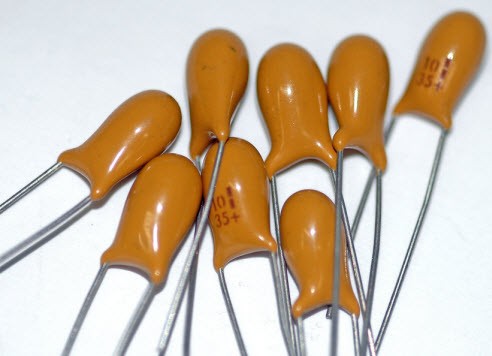
Capacitor
The capacitor has an ability to store a charge called as a capacitance of that capacitor. It is measured in Farads but it is a large unit; for smaller capacitor, capacitance is rated as micro farad, nano farad, picofarad, etc.
The energy stored or charge (Q) in a capacitor is given as
Q = CV
Where
C is the capacitance of the capacitor and
V is the applied voltage.
And also current is nothing but a rate of flow of charge; the current through the capacitor is given as
I = C dV/dt.
Depending on the construction and materials used, the capacitors are of different types like film, ceramic, electrolytic, polymer capacitors, and so on. These capacitors are used for different applications like energy storing, power factor improvement, phase shifting, filtering, etc. Let us consider a polyester capacitor and the various methods that are used to find its capacitance.
Polyester Capacitor
Based on the dielectric material, metal film capacitors are of either polypropylene or polyester capacitors. Polyester capacitors are considered as standard for many DC applications wherein the cost is the main consideration for low tolerance values. A Polyester capacitor offer a very low tolerance value, which equivalent to 5% or 10%. These capacitors use s layers of metal and Mylar dielectric or polyester in order to make a wide range of capacitance values. A polyester film is placed in between the two plates of this capacitor.
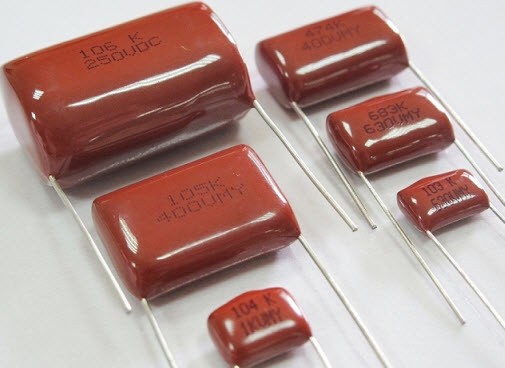
Polyester Capacitor
These capacitors are available in the range of 1nF to 15uF rated at voltages from 50V – 1500V. These capacitors have high temperature coefficient values and isolation resistances. As the polyester capacitor has high capacitance per unit volume, it comes in smaller size for high capacitance values compared with the other types of capacitors. These major features of polyester capacitor make it as widely used, cheapest and most popular type of capacitor.
Finding Value of Capacitors
The value of capacitors can be determined by several ways depending up on the type of capacitor like electrolytic, disc, film capacitors, etc. These methods include value or number printed on the body of the capacitor or color coding of the capacitor.
Number Coding of Capacitor
Ceramic type of capacitors is coded in its body, but these is a little bit confusing as compared to color coding. Some of the capacitors have only two digit number and most of them have three digit number. The digit value is numbered in Pico Farads. There are different methods to identify the capacitor and to calculate its value. The most popular method is three digit number along with special number and these alphabets can refer tolerance, voltage rating, temperature coefficient, dielectric material, etc.
In this type of coding, the first two digits are significant digits and the third digit is a multiplier and alphabet represents the tolerance value as given in the table.
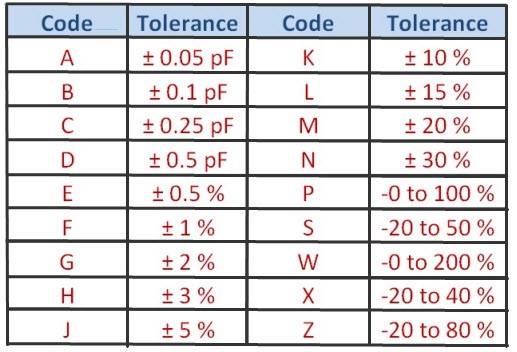
Capacitor Number Coding Chart
By referring to the above table, one can acknowledge the value of the capacitor, easily. Follow the below example for a better understanding. In the below example, the first two digits represent the first and the second significant digits (10) and the third one is a multiplier (2=100 as per table); and, alphabet represent tolerance (K= 10%) value as shown in the figure.
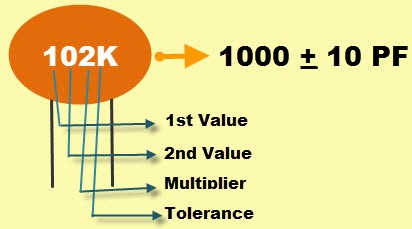
Capacitor Number Coding
Some more methods of finding the capacitor values include the following
1. The number printed on the capacitor’s body represents the capacitance value in Pico Farads.
For example, 8 = 8PF
2. If the third number is zero, then the value is in Picofarad
For example, 100 = 100PF
3. For a 3-digit value, the third digit represents the number of zeros after the second digit
For example, 104 = 10 – 0000 PF
4. If the value is obtained in PF, then it is easy to convert it into KPF or uF
For example, PF / 1000 = KPF or, PF / 10, 00000 = uF. For a capacitance value of 104 or 100000 in pF, it is 100KpF or n or 0.1uF.
5. For a 4-digit number, if the 4th number is a zero, then the capacitance value is in pF.
E.g. 1500 = 1500PF
6. If the number is a floating point decimal number, then the capacitance value is in uF.
E.g. 0.1 = 0.1 uF
7. If an alphabet is given between the digits, it represents a decimal and the value is in KPF
E.g. 2K2 = 2.2 KPF
8. If the values are represented with slashes, then the first digit represents value in UF, the second digit gives tolerance and the third represents maximum voltage rating.
E.g. 0.1/5/800 = 0.01 uF / 5 % / 800 Volt.
Capacitor Color Coding
As like resistor value finding by color coding, capacitors are also color coded for identifying their values. Mostly unpolarized polyester capacitor or mica molded capacitors are color coded. In case of Color coded capacitors, capacitor body consists of color bands and by using a capacitor color code chart we can easily identify the capacitor value.
The first color is considered as the 1st digit in color chart, the second color band is 2nd digit, the third band is a multiplier, the 4th band is tolerance and the fifth color band is voltage rating of the capacitor. The capacitor color code chart is given below to identify the value of the capacitor.
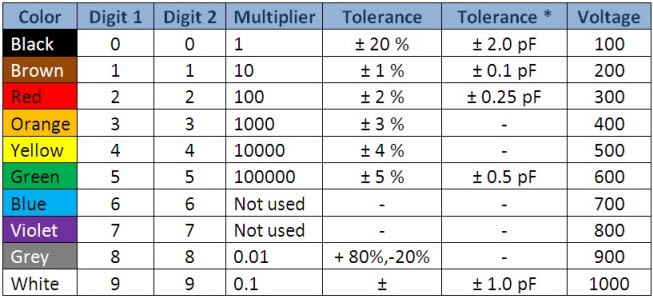
Capacitor Color Coding Chart
For example, consider the below capacitor wherein each color is represented with some value. The first band is orange that has value of 3 in the above chart, the second band is yellow 4, and the third one is 0.1 multiplier and the fourth band red is 0.25 tolerance.
Then its value is 34*0.1 pF with a tolerance of 0.25; finally, it is 3.4pF with a tolerance of 0.25 as shown in the figure.

Capacitor Color Coding
This is about the capacitors and their values finding as both number and color code. After reading this article, one can easily find out the value of the polyester capacitor either by color code or number code. We can also find the capacitor value by LCR meter which reduces the effort needed to remember all these colors and numbers. Post your comments, doubts and suggestions about this article in the comment section below.
Photo Credits: